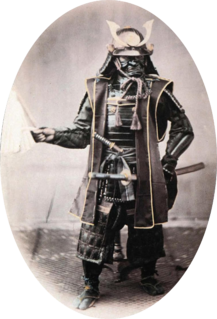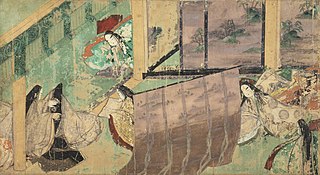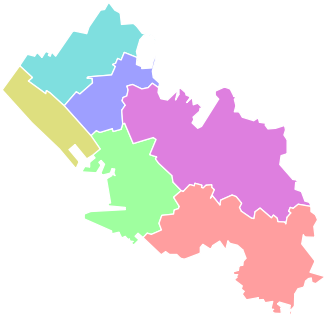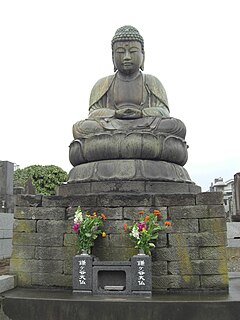| Chiba 千葉市 | ||
|---|---|---|
| Designated city | ||
 Top: Coastal industrial area, Chiba Folk Museum Middle: Makuhari Messe, Chiba Port Tower, Chiba Marine Stadium Bottom: Skyscrapers of Makuhari on the coast. | ||
| ||
 Location of Chiba in Chiba Prefecture | ||
| Coordinates: 35°36′26.2″N140°06′22.9″E / 35.607278°N 140.106361°E Coordinates: 35°36′26.2″N140°06′22.9″E / 35.607278°N 140.106361°E | ||
| Country | Japan | |
| Region | Kantō | |
| Prefecture | Chiba Prefecture | |
| Government | ||
| • Mayor | Toshihito Kumagai | |
| Area | ||
| • Total | 271.76 km2 (104.93 sq mi) | |
| Population (February 1, 2016) | ||
| • Total | 972,861 | |
| • Density | 3,580/km2 (9,300/sq mi) | |
| Time zone | Japan Standard Time (UTC+9) | |
| -Tree | Zelkova serrata | |
| – Flower | Nelumbo nucifera | |
| – Bird | Little tern | |
| Phone number | 043-245-5111 | |
| Address | 1-1 Chiba-minato, Chūō-ku, Chiba-shi 260-8722 | |
| Website | https://www.city.chiba.jp/ | |
| Chiba | |||||
"Chiba" in kanji | |||||
| Japanese name | |||||
|---|---|---|---|---|---|
| Kanji | 千葉 | ||||
| Hiragana | ちば | ||||
| Katakana | チバ | ||||
| |||||
Chiba(千葉市Chiba-shi, Japanese: [tɕiꜜba] ), literally "Thousand(s) Leaves", is the capital city of Chiba Prefecture, Japan. It sits about 40 kilometres (25 mi) southeast of the center of Tokyo on Tokyo Bay. [1] Chiba City became a government-designated city in 1992. In February 2016, its population was 972,861, with a population density of 3,580 people per square kilometer. The city has an area of 271.76 square kilometres (104.93 sq mi).

A city is a local administrative unit in Japan. Cities are ranked on the same level as towns and villages, with the difference that they are not a component of districts. Like other contemporary administrative units, they are defined by the Local Autonomy Law of 1947.

Chiba Prefecture is a prefecture of Japan located in the Kantō region, and the Greater Tokyo Area. The sixth most populous prefecture, and 27th largest by land area, Chiba is on the east coast of Honshu and largely consists of the Bōsō Peninsula, which encloses the eastern side of Tokyo Bay. Its capital is the city of Chiba.

Japan is an island country in East Asia. Located in the Pacific Ocean, it lies off the eastern coast of the Asian continent and stretches from the Sea of Okhotsk in the north to the East China Sea and the Philippine Sea in the south.
Contents
- Etymology
- History
- Early history
- Medieval period
- Later history
- Modern history
- Climate
- Demographics
- Politics and government
- Wards
- Culture
- Facilities
- Sports
- Transportation
- Airports
- Railway
- Highway
- Education
- Colleges and universities
- High schools
- Elementary and middle schools
- International schools
- Hospitals and clinics
- Twin towns – sister cities
- Notable people
- See also
- References
- External links
Chiba City is one of the Kantō region's primary seaports, and is home to Chiba Port, which handles one of the highest volumes of cargo in the nation. Much of the city is residential, although there are many factories and warehouses along the coast. There are several major urban centers in the city, including Makuhari, a prime waterfront business district in which Makuhari Messe is located, and Central Chiba, in which the prefectural government office and the city hall are located.
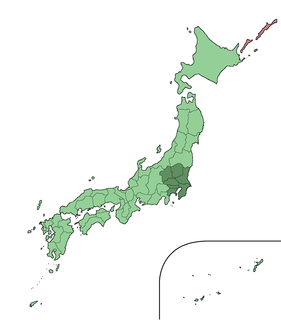
The Kantō region is a geographical area of Honshu, the largest island of Japan. The region includes the Greater Tokyo Area and encompasses seven prefectures: Gunma, Tochigi, Ibaraki, Saitama, Tokyo, Chiba, and Kanagawa. Within its boundaries, slightly more than 45 percent of the land area is the Kantō Plain. The rest consists of the hills and mountains that form the land borders. According to the official census on October 1, 2010 by the Japan Statistics Bureau, the population was 42,607,376, amounting to approximately one third of the total population of Japan.

Makuhari (幕張) is a community in Chiba City, Chiba Prefecture, Japan. It is within Hanamigawa-ku and Mihama-ku.
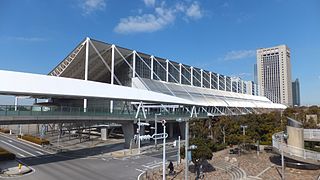
Makuhari Messe (幕張メッセ) is a Japanese convention center outside Tokyo, located in the Mihama-ku ward of Chiba city, in the northwest corner of Chiba prefecture. Designed by Fumihiko Maki, it is easily accessible by Tokyo's commuter rail system. Makuhari is the name of the area, and Messe is a German language word meaning "trade fair".
Chiba is famous for the Chiba Urban Monorail, the longest suspended monorail in the world. Some popular destinations in the city include: Kasori Shell Midden, the largest shellmound in the world at 134,000 m2 (160,000 sq yd), Inage Beach, the first artificial beach in the nation which forms part of the longest artificial beach in Japan, and the Chiba City Zoological Park, popular on account of the standing red panda Futa.

The Chiba Urban Monorail is a two-line suspended monorail system located in Chiba, Chiba Prefecture, Japan. It is owned and operated by Chiba Urban Monorail Co., Ltd, a so-called "third-sector" company established on March 20, 1979. Investors include Chiba Prefecture and the city of Chiba.
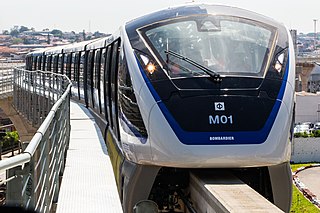
A monorail is a railway in which the track consists of a single rail. The term is also used to describe the beam of the system, or the trains traveling on such a beam or track. The term originates from joining "mono" (one) and "rail" (rail), from 1897, possibly from German engineer Eugen Langen, who called an elevated railway system with wagons suspended the Eugen Langen One-railed Suspension Tramway.

The red panda is a mammal native to the eastern Himalayas and southwestern China. It is listed as Endangered on the IUCN Red List because the wild population is estimated at fewer than 10,000 mature individuals and continues to decline due to habitat loss and fragmentation, poaching, and inbreeding depression.



